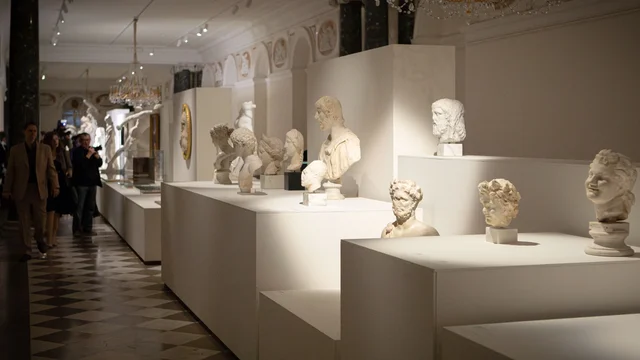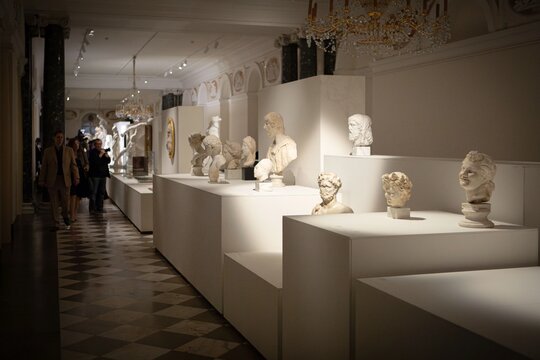Anatomy of Antiquity. Body and Movement in Sculpture
How did antiquity inspire artists and shape the artistic education of subsequent generations? What did the great, unfulfilled dream of King Stanisław August – to establish an academy of fine arts in Warsaw – mean for Polish art? The answers to these questions are provided by the latest exhibition at the Royal Library. At the Castle exhibition, you can get up close to original ancient sculptures and historic copies in marble and plaster – including surviving relics of King Stanisław August’s impressive collection. Walk around them from every side and study details that are usually difficult to see. This is a rare opportunity to experience antiquity up close – literally.
„Anatomy", already present in the title of the exhibition, refers to the fascination with the human body – so characteristic of ancient art. The artists of that time sought to understand its structure, composition, and capabilities, in order to represent every aspect of the human figure with precision in sculpture. On a more metaphorical level, the term anatomy also refers to modern interpretations and adaptations of ancient models, which were central to the ideals of classicism” – says Norbert Haliński, curator of the exhibition.
During the reign of Stanisław August (1764–1795), the Castle was not only the main centre of political and court life, but also a hub of artistic activity. It was here that new trends in art and artistic education took shape under the influence of Enlightenment thought. The ruler’s taste was deeply influenced by ancient art. The Painting and Sculpture Workshops operating within the Castle walls were intended to form the foundation of the Academy of Fine Arts – the king’s unrealised dream. Inspired by the schools of Dresden and Rome, the castle workshops made use of anatomical atlases and casts of antique sculptures imported from Italian studios. With the academy in mind, Stanisław August assembled plaster copies of the most outstanding ancient sculptures. The royal collection grew to over five hundred pieces, making it one of the largest in Europe. These casts were used by generations of young artists until the outbreak of the Second World War, during which most of the figures were destroyed. However, some survived – and can now be seen in the current exhibition at the Castle.
The exhibition features nearly 130 objects, on loan from institutions including the Jagiellonian University Museum, the National Museum in Warsaw, the University Library in Warsaw, and the Museo Gypsotheca Antonio Canova in Possagno, Italy. It includes original ancient sculptures, plaster casts used by art students in the 18th and 19th centuries, and works by artists inspired by antiquity. Among the works on display in the Royal Library are pieces by artists such as Jan Chrystian Kamsetzer, Dominik Merlini, Franciszek Smuglewicz, Olga Boznańska, Jacek Malczewski, Kazimierz Alchimowicz, André Le Brun, Jean-Antoine Houdon, Francesco Massimiliano Laboureur, and Antonio Canova.
The selection of objects offers an opportunity to trace the evolution of ancient representations of the human body – from static to dynamic, from simplified forms to extraordinary anatomical precision. Visitors can also explore how the function, reception, and reinterpretation of classical models changed in modern Europe.
Visitors will certainly be drawn to part of the Castle’s collection of gem casts – miniature, relief-decorated precious and semi-precious stones. In the 18th century, these were popular souvenirs inspired by antiquity, often brought back from travels to Italy. The exhibition also offers a unique opportunity to view works by Antonio Canova and plaster casts of iconic ancient sculptures from major institutions such as the Louvre, the Vatican Museums, and the Capitoline Museums.
Although the exhibition is divided into nine thematic sections, visitors are free to explore the displays at their own pace. This allows for the discovery of different adaptations and interpretations of the same iconographic motifs in both ancient and modern works. In the exhibition design, elements from the scenography of previous displays have been reused – breathing new life into the material, just as is the case with plaster and stone.
The exhibition is accompanied by an educational programme tailored to different age groups, as well as a wide range of events, including curatorial tours, guided visits for people with special needs, and expert-led talks. We also recommend the online lectures associated with the exhibition.
We invite you to explore the exhibition catalogue, available for purchase in the on-site shop as well as online.
The exhibition is open to visitors from 13 June to 21 September, Tuesday to Sunday, from 10:00 am to 6:00 pm (last entry at 5:00 PM).
Location: The Royal Library
Curator: Norbert Haliński
Event coordinator: Paweł Martosz
Scenography: Marcin Kwietowicz, Karol Żurawski, Szymon Chwazik
Ticket Prices:
Standard – 30 PLN
Reduced – 20 PLN
Special (with a ticket to any permanent exhibition) – 1 PLN






